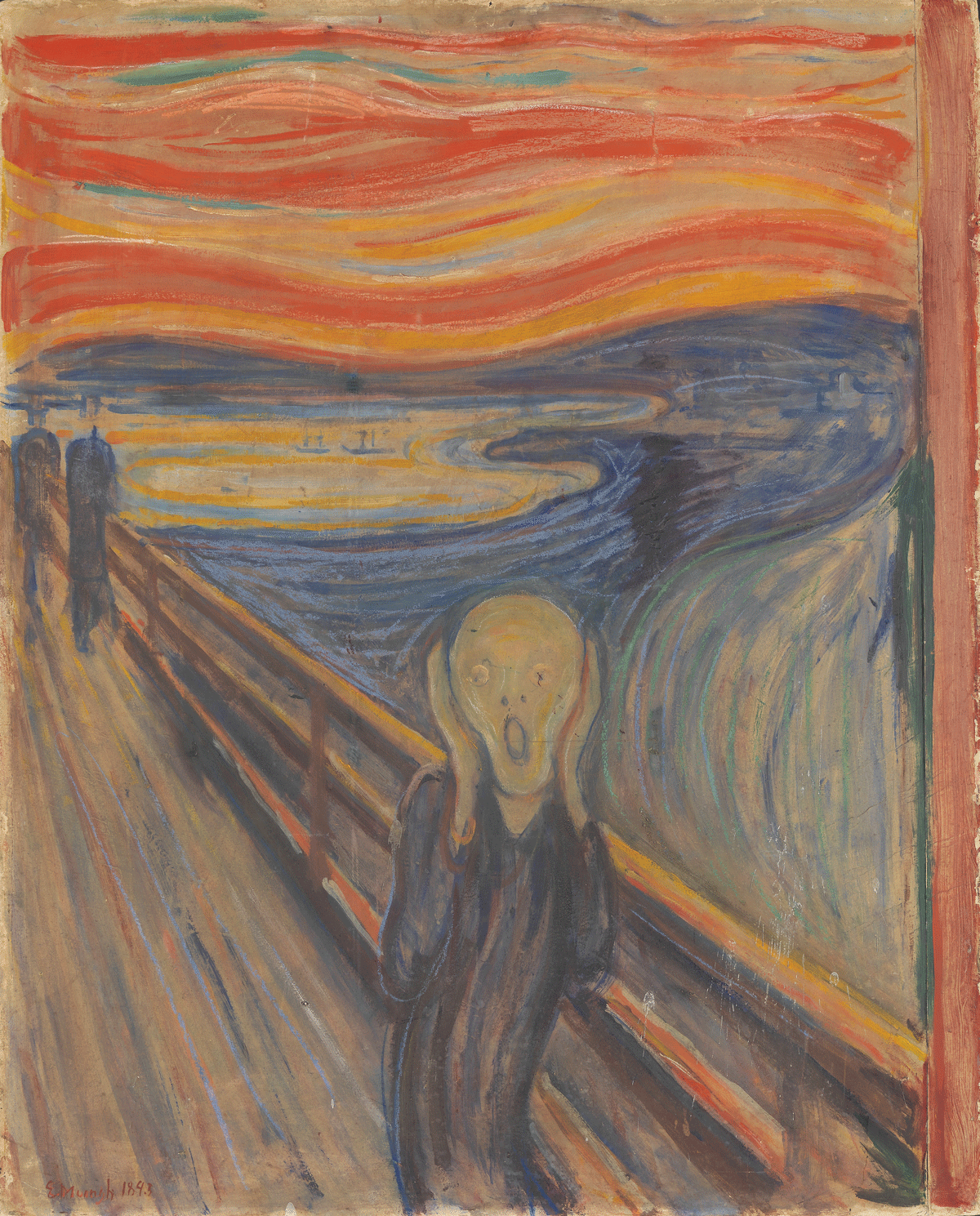« Features
The Paradox of Expressionism
For the purposes of this essay, I shall define expressionism-à la the Romantic movement of the 19th century-as the theory that one of the main functions of artworks, if not their very essence, is that they somehow ‘contain,’ ‘suggest,’ or ‘give voice to’ human feelings. I shall not be concerned with the theory that artworks do these things with regard to ideas. It seems clear that they do, however that involves a cognitive theory of art that I will address at another time.
For the sake of simplicity, we could use Leo Tolstoy’s definition of art as paradigmatic: “Art is a human activity consisting in this. That one man consciously, by means of external signs, hands on to others feelings he has lived through, and that others are infected by these feelings and also experience them.” (Tolstoy’s What is Art?) This is ostensibly a simple input/output theory. The artist puts feelings into a work of art and the audience receives these feelings as a sort of ‘infection’ or ‘contagion.’ It will not be relevant for my essay to debate whether we should take this ‘handing on of feelings’ in a strong or weak sense. That is, I will not be concerned with whether the artist is experiencing said feelings at the exact moment of creating the artwork or whether she is remembering earlier feelings and transposing them during later artistic creation. (It’s likely that Tolstoy held the weaker claim since the stronger is susceptible to many more obvious counter-examples.)
This being said, I believe there is a fundamental paradox involved with expressionism as the Romantics and Tolstoy understood it: the vast majority of artworks, it seems, are inanimate and are thus incapable of expressing feelings in any literal or straightforward way. I’m being deliberately simplistic here. Unless we are considering forms of artistic expression where the human face and/or body are depicted or Disneyesque analogues where mice and trees (et. al.) having human qualities are depicted-and there are undoubtedly similar exceptions-most works of art are ‘mute objects.’ They are not sentient and are thus incapable of expressing feelings. And yet, it is an undeniable phenomenological experience of critics and audiences alike that they continuously find whole ranges of feelings involved in their interactions with even the most abstract and non-objective art forms. How can this be explained?

Edvard Munch, The Scream, 1893, tempera and crayon on cardboard, 36” x 28.9.” National Museum, Oslo, Norway. Donated by Olaf Schou, 1910. Source: Wikimedia Commons.
One way is to take a causal approach. We might argue that a work of art can be said to be expressive of feelings if it causes audiences to feel what the artist felt (or weakly, if it causes audiences to have any feelings at all). This was Tolstoy’s view, but the problem here is that ‘X expresses feeling Y’ is not semantically or philosophically the same as ‘X causes feeling Y.’ They are independent claims. If, for example, a Requiem Mass by Bach causes one to feel solemn and sad, we may still be unclear as to how the Mass as such expresses these feelings. What did Bach do to make the music itself solemn and sad? Obviously, one might respond that the sadness is a function of tempo and key considerations: the Mass has a slow tempo and is played in a minor key, with the implication perhaps that sad people themselves act and speak in this manner. But this cannot be true across all cultures and there are many counter-examples, such as a jazz funeral that might feature faster music in a major key. So the causal approach does not seem to be one that can solve the fundamental paradox of expressionism.
Very briefly, two other approaches to the paradox. ‘X expresses feeling Y’ might mean that X describes or depicts someone feeling Y. I touched on this above. For instance, certain paintings, drawings, or illustrations may be said to express suffering if they actually depict someone who seems to be suffering (such as a painting of Christ’s crucifixion or Munch’s The Scream). This approach works in a few cases but its general applicability is in doubt because counter-examples are easy to imagine, such as emotive attributions to drip paintings. Additionally, ‘X expresses feeling Y’ might mean that X treats something in a way that demonstrates Y. Thus, a sculpture may be said to express love if it was made in a loving fashion. The success of this approach seems to presuppose that the audience would have access to or some reliable evidence about the creative process, but often that is not the case. It is also possible that an artwork which was made in a loving fashion could still seem to express hate or almost any other emotion.
The American philosopher Robert Stecker has also articulated a theory of expressionism called hypothetical intentionalism:
Applied to music, the view now being proposed is that a musical
passage is expressive of an emotion if the best hypothesis of an
ideal listener is that the composer intended the emotion to be heard
in the music. (Robert Stecker, Aesthetics and the Philosophy of Art)
Stecker’s theory is suggestive and generalizable to other art genres, but problems remain. The first is that of the concept of an ‘ideal listener’ (or more generally, that of an ‘ideal audience’). In theory, such a listener would be a properly backgrounded listener who is well-acquainted with the composer’s works and musical time period, and who experiences the piece in the proper context. She would form the best hypothesis as to the composer’s intended emotion based on formal and contextual evidence relating to the music. However, it is clearly possible to have two or more ideal listeners who completely disagree about intended emotions. Also, Stecker’s theory doesn’t address the issue of what it means to say that the artist intended the emotion to be experienced in the artwork from the onset of its creation. How does that happen?
I would like now to present a triadic approach that might begin to solve the paradox of expressionism. The obvious triad is the artist, the work, and the audience. Let’s begin with the first two.
In a suggestive article, the American philosopher David Goldblatt has claimed that there is a ‘ventriloquial exchange’ that occurs in the relationship between artists and their putatively expressive works (David Goldblatt, “Ventriloquism,” in Aesthetics: A Reader in Philosophy of the Arts). He cites the example of Edgar Bergen and his dummy Charlie McCarthy. Bergen was so adept in his skills that audiences had the distinct impression that he was actually carrying on a comedic conversation with Charlie at the same time that they implicitly recognized the illusion and knew that Bergen was really only talking to himself. Goldblatt sees these two dimensions of ventriloquism as ontological levels that interweave in subtle ways. Thus, it may be said that Bergen was engaged in an ecstasis-or ‘standing out’ of the self-so as to create a new voice through the character of Charlie. Just as Charlie was indeed the voice of Bergen (i.e., he had been created by Bergen), so were possible selves in Bergen actualized by his interactions with Charlie. Goldblatt generalizes this point by suggesting that all artistic creativity involves ventriloquial action, or the artist ‘throwing her voice,’ in the relationship between artist and medium: sometimes she gets the impression that she is speaking or revealing emotions through the piece, and other times she gets the impression that the artwork is speaking to her. Pointedly, Goldblatt references Foucault in his analysis. The ventriloquial interchange, he argues, is similar to Foucault’s idea that an author and her work open up a kind of ‘space’ in which many voices can speak, and it is often unclear who or what is more dominant-the writer, the intertext, or that which is written-or even where one begins and the other ends.
In this context, I want to add to Goldblatt’s account the theory of the British philosopher Anne Sheppard. Sheppard comes at expressionism from the side of the audience and argues that the interchange of feelings between artworks and audiences relies upon ‘imaginative projection,’ a species of the willful suspension of disbelief. For example, when a viewer sees an action painting that seems expressive of anxiety, she imagines what it is like to be anxious, even though she is not actually anxious. Of course, such a projection can only work given a history of certain kinds of experiences the viewer has had, but with this history in place, it is not surprising that seeing the painting will enable her to ‘sense its anxiety.’ To be sure, this is a curious anxiety that only mimics real anxiety: experiencing the painting and sensing its anxiety is hardly the same as feeling anxious about, say, a real terrorist attack. It is an illusory anxiety that seems to coordinate logically enough with art’s being a realm of virtual or imaginary space. No doubt, there are many other factors that influence the sensing of anxiety in the painting, such as the title of the piece, the context in which it is experienced, the viewer’s mood at the time, the artist statement (if any), and the possible reactions of others who are also viewing it. But imaginative projection is clearly the key that allows the viewer to ‘find’ the state of anxiety immersed in the work. Such an explanation would work for other art forms as well, and has the added virtue of being open to empirical findings about correlations between artistic techniques and psychological states.

Matthew Blackwell, Crossing Over (Installation view), 1995-2011, tin, metal studs, enamel, mixed media, 76.5” x 130” x 32.” Courtesy of the artist.
If we combine Goldblatt’s ventriloquial theory with Sheppard’s thoughts about imaginative projection, we arrive at a triadic approach to the paradox of expressionism. Admittedly, there is a kind of artistic magic that occurs when we encounter works of art that speak to us emotively, and it is likely that no analytic approach can fully penetrate this magical veil. Still, it is useful, I believe, to regard emotionally charged artworks as intertextual spaces where artists have ‘thrown their voices’ and sensitive audiences have stepped imaginatively into these spaces in such a way that the works can tell us in their own way ‘how they feel’ about some aspect of the world and human existence.
Bibliography
- Goldblatt, David. “Ventriloquism,” in Aesthetics: A Reader in Philosophy of the Arts. New York and London: Routledge, 2017.
- Stecker, Robert. Aesthetics and the Philosophy of Art: an introduction. Lanham, MD: Rowman & Littlefield Publishers, Inc., 2005.
- Tolstoy, Leo. What is Art? Indianapolis, IN: Hackett Publishing Company, Inc., 1996.
John Valentine is a professor of philosophy at the Savannah College of Art and Design, where he has taught since 1990. His publication credits include the textbook Beginning Aesthetics (McGraw-Hill, 2007); articles in the Florida Philosophical Review, the Southwest Philosophy Review, the Journal of Philosophical Research, the Journal of Speculative Philosophy and The Philosopher; poetry published in various journals, including The Sewanee Review, The Midwest Quarterly and the Southern Poetry Review, among others; and six chapbooks of poetry.






































Leave a Reply
You must be logged in to post a comment.